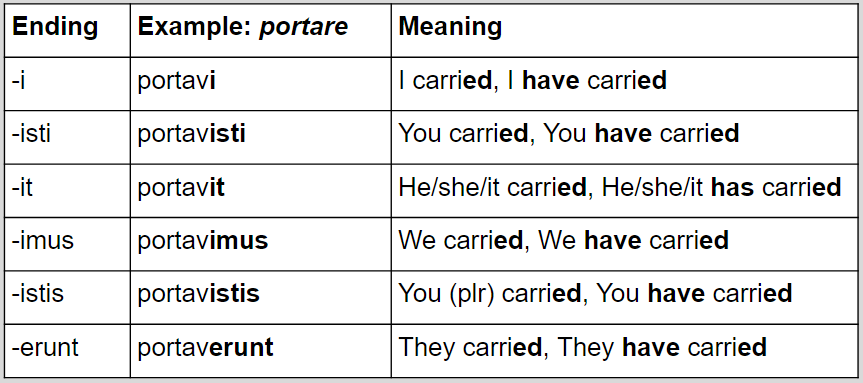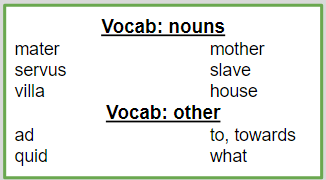Perfecting the Perfect Tense
January Latin Challenge: Day 13 of 31
Today we are going to be looking at the Perfect tense in Latin.
Before we start, get my free guide to all the verb endings in Latin by signing up below. It is got everything you need to help you identify all verbs in Latin, from the basics right the way through to the most advanced grammar. It has all the endings for every tense, voice and mood, so will be really useful as you start getting familiar with these verb endings. You probably won’t need it all at once, but one day it will all come in really handy.
I am only going to do active verbs in this post - if you want passive verbs, that is a separate post that will be coming towards the end of the January Latin Challenge on bambasbat: probably around Day 29.
So: What on earth is the perfect tense?!
To start with, the perfect tense is what is called a “completed action in the past”. It is an action that happened at a point in time, and is over.
I walked into a door.
This is a good example. At one point in time, I walked into a door. The verb walked shows me that its over - I am not still walking into the door. Walked is in the perfect tense, and in Latin that would be very clear from the ending.
Translating the Perfect Tense
When you are translating the perfect tense, the important thing to remember is -ed. This is how you should aim to translate it, but of course English likes to be difficult, so while “walked” fits my rule, “ran”, “sat”, and “heard” don’t. Just keep in mind that the perfect tense is a past tense action which is completed.
You can also translate it using “have or has…”, such as “I have walked to the shop”, “he has thrown away his socks”, so keep that at the back of your mind as we go through, in case that makes more sense in the context of the sentences.
The Perfect Tense in Latin
Now, while the imperfect is easy to remember with the one rule of -ba- as we saw yesterday in Day 12 of the January Latin Challenge, and the future and pluperfect are pretty self evident as well, the perfect is a bit more of a challenge to spot. HOWEVER, people have been learning Latin for literally thousands of years, so there just so happens to be a really helpful way to know perfect tenses.
In your dictionary, verbs are given like this.
porto, portare, portavi, portatus
These are called the 4 principal parts.
porto: The first is the present tense 1st person singular: I carry.
portare: The second is the present active infinitive: to carry.
portatus: The fourth is what’s called the perfect passive participle, having been carried. We will look at this more later in January, probably around Day 20.
The third principal part is what we want today. portavi is the perfect 1st person singular, and it shows us the perfect stem. It is there to show us how verbs change in Latin when they are in the perfect tense.
As you can see from this example, porto doesn’t change a lot, but it does change a bit. It is similar to the present stem, but we have added a -v- and a different ending. This -v- is one of my perfect signifiers. We will look at some others in a minute.
How does this help me?
To form the perfect tense in Latin, we take this 3rd principal part - the perfect stem. Then, we add our perfect person endings.
The perfect endings are a bit different than the usual -o -s -t -mus -tis -nt endings that can take us through a lot of the tenses. For the perfect, we have -i, -isti, -it, -imus, -istis, -erunt.
As you can see from the table below, it is a whole new set of verb endings to get your head around, but there are some similarities to the present tense in the 3rd singular and plural, and the 1st plural which can help you out.
Perfect Signifiers
However, although a lot do, not all Latin verbs use a -v- as a perfect signifier. There are a few to choose from! I like to call them the SUSSEX verbs, as we can use the letters from this word to show us some other signifiers to remember as well as -v-.
s
u
ss
x
They are used in perfect verbs such as hausit; monuit; discessit; dixit.
As you can see there are a wide range of signifiers, but DON’T PANIC. It seems overwhelming, but don’t forget - your dictionaries and vocab lists should all give verbs using the principal parts. When you learn vocabulary, make sure you learn all the principal parts for verbs. You will find it helps a heck of a lot, especially when it comes to the really irregular ones such as fero, ferre, tuli, latus.
So keep the endings in mind, -i, -isti, -it etc, just in case you forget the principal parts of some of the trickier ones, because even when the stem changes insanely, like fero, the endings will match my perfect tense ending table.
Examples of the perfect tense
Here are 3 sentences. Remember that in Latin, the verb is often at the end of the sentence or clause. As usual, I have the vocab below, with all principal parts of the verb listed. If you want a go at translating these on your own, pause here, and the explanations follow so only move on when you want to know the answers.
servi ad villam festinaverunt.
“salve mater!”, clamavisti.
quid fecimus?
Explanations below! Only read on when ready.
servi ad villam festinaverunt.
Always find the verb first, as it tells you what else to look out for in the sentence. In this case, the verb is festinaverunt - I know from the -erunt ending that it is perfect, and a 3rd person plural - “they hurried”.
Now I look for a nominative to match it, and servi works here - “the slaves”.
ad villam rounds it off, “to the house”.
All together, “the slaves hurried to the house”.
Remember, you can also translate it as “have hurried” if it makes more sense in your translation.
“salve mater!”, clamavisti.
We have speech marks here, so I am expecting some sort of speaking verb (it sounds obvious, but it is so easy to forget). clamavisti is the verb, and I know that it is a perfect tense 2nd person singular - “you shouted”.
Now I look inside the speech - salve means “hello” and mater is “mother”.
The sentence means ‘“Hello mother!” you shouted’.
Remember you can move the verb in your translation if it makes more sense, so you could say ‘you shouted “hello mother!”’.
quid fecimus?
fecimus is a verb that changes a lot in the perfect stem. If you look in the vocab, you will see it is facio in the present tense, but the third principle part changes to feci. That’s my perfect stem remember, and -isti is added to this to make it a 1st person plural verb. So this means “we did”.
quid means “what”.
We are going to be bestoff using our secondary meaning of the perfect tense in this sentence - “what have we done?”.
And that’s the perfect tense in Latin! Don’t forget to download the complete guide to Latin verbs from this page, it will really help as you practise recognising your different tenses.
I hope you have found this useful! Thanks for watching, and I’ll see you tomorrow on bambasbat for Day 14 of the Latin January Challenge!




